The engine of the 500-horsepower speedboat is fired up and within minutes the natural majesty of Song Saa Private Island is little more than a blip on the horizon. As Cambodia’s first luxury island resort disappears from view, with its smiling staff frantically waving goodbye, time briefly stands still.
For Song Saa has adopted its own time zone. Known as ‘island time’, any soul fortunate enough to find themselves mindlessly kicking along the pristine white sands, luxuriating in one of the resort’s 27 bungalows, or enjoying eye-widening creations at the fine-dining restaurant, is doing so one hour ahead of the rest of Cambodia.
Upon arriving back on the mainland, it is necessary not only to reconvene with reality, but also to reconfigure timepieces. Island time is designed to make life just that little bit easier in surroundings where such cosseting is patently not necessary. On Song Saa, it seems as if the sun rises and sets a little later, providing an apparent extra hour in bed for early-risers, or a longer afternoon for sunset-gazers.
In a tourism market so reliant on temples and tragedy, it is hoped that Song Saa can be the catalyst for a new conversation – one that looks to Cambodia’s future, rather than its past, and proves that world-class destinations need not be the preserve of the country’s Southeast Asian neighbours.
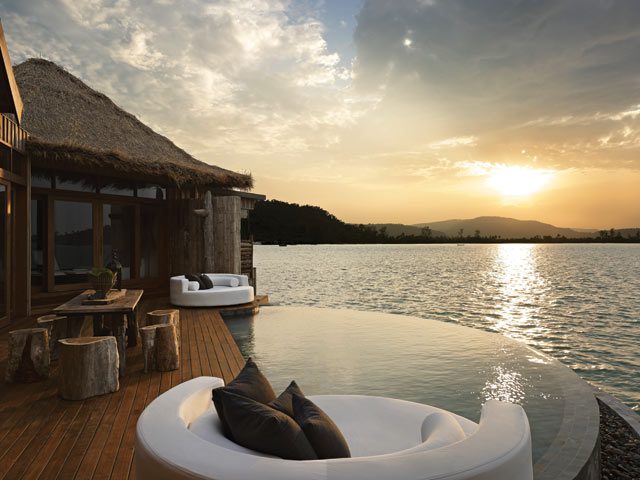
This is apparent from the moment the rustic luxury of its accommodations is revealed: a bed so soft that it is difficult to stifle a chuckle upon your first visit; enveloping oneself in the chenille microfiber robes is akin to being wrapped in a cloud and, on the initial guided tour of the villa, few visitors will fail to mentally set aside an hour or two to wrinkle in the huge terrazzo sunken baths with magnificent views of the Gulf of Thailand.
Yet Song Saa soon proves to be more than just Cambodia’s most lavish resort. Its two islands are connected by nothing more than a wooden footbridge, with Koh Ouen the site of almost all facilities and accommodation, and Koh Bong remaining largely untouched emergent rainforest.
The desire to tread lightly first becomes apparent when staff politely request that guests not use shampoo in their villa’s outdoor showers “because of the damage to the sea environment”. Further inspection soon reveals that driftwood found washed up on the western shores of local islands permeates practically every structure on Song Saa. The scaviola plants and pandanis trees that line the sand walkways were chosen because of their nativity to the area. The kitchen doors in villas are made from recycled fishing boats that had sailed their last voyage.
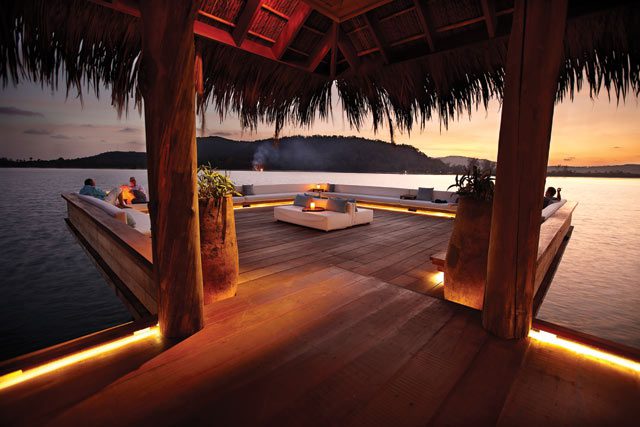
Six years ago, husband and wife team Rory and Melita Hunter chartered a fishing boat of their own and set off on a two-week adventure to explore Cambodia’s islands. By the time they arrived back onshore, they had been offered the chance to buy both Koh Ouen and Koh Bong from the islands’ inhabitants and land title owners, many of whom were keen to return to the mainland.
“It was such a crazy, left-of-centre proposition that we sort of said yes, there and then. And that was the catalyst for everything,” explains Rory. “We never set out to find an island and build a luxury resort. It came with a big sense of responsibility, to do it right and set good benchmarks and standards on how to treat the environment, how to respect the local community… we had to engage at that local level.”
That meant creating what the Hunters refer to as a ‘triple bottom line’ business, where people and the planet are added into the equation alongside profits. “A perfect example is that if we bulldoze that island over there and build a skyscraper, that would dramatically impact our profits because we have destroyed the planet,” says Rory.
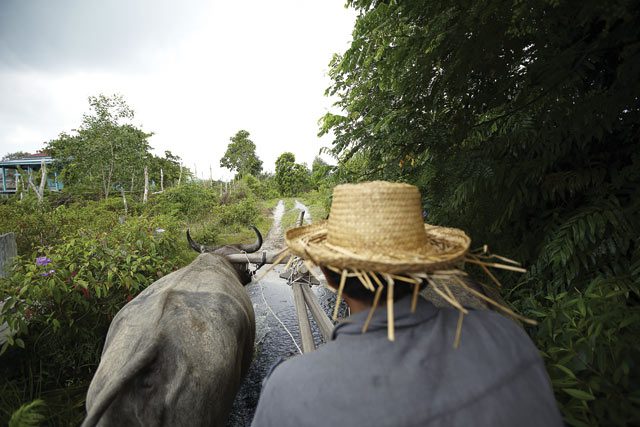
While en route to Song Saa’s neighbouring island of Koh Rong for a refined picnic on ‘five-mile beach’, Barnaby Olson, Song Saa’s head of conservation, explains the resort’s many environmental schemes. When relaxing on this stretch of beach, where the sand is like icing sugar, so delicate it squeaks underfoot, it is particularly easy to understand the desire to protect the Koh Rong archipelago’s natural charms.
The resort has established, and is monitoring, a marine protected area that extends 200 metres around both of its islands. This is in the process of being extended to an area of 14 square kilometres, and a carbon-offsetting scheme for guests is also on the horizon.
Artificial reefs have been created and deployed underneath the overwater villas to increase the complexity of the habitat, while ‘the coral garden’ will be a monitoring site that produces some of Cambodia’s only solid, long-term scientific data on environmental issues and processes such as coral bleaching.
According to Barnaby, all of the resort’s work is introduced to, and run in conjunction with, local communities. “It’s never us going in and saying this is what we’re doing, live with it,” he explains. “We try to give them as much involvement as possible.”
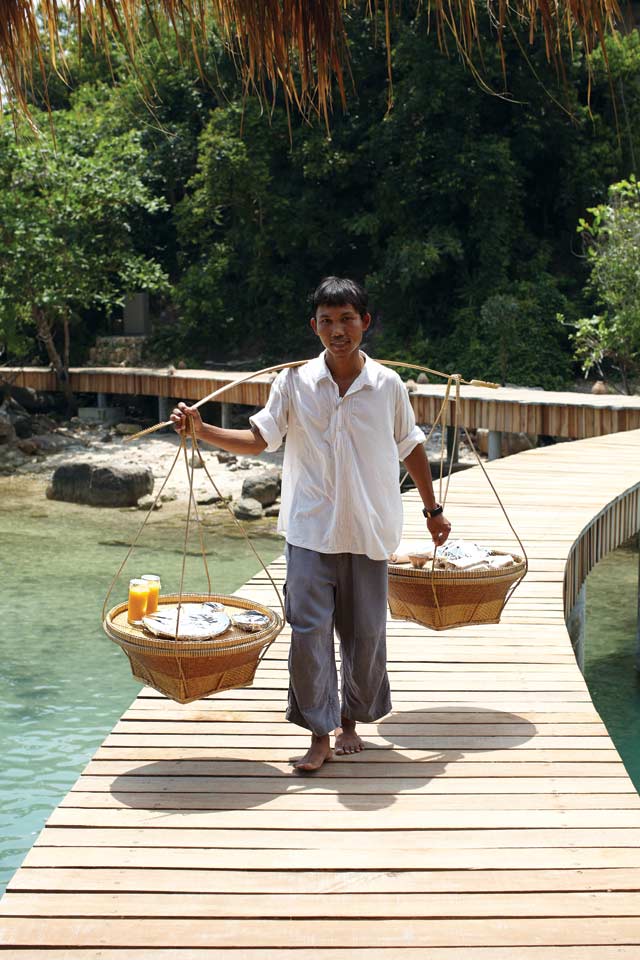
Song Saa offers a number of guest ‘encounters’ – from water sports and snorkelling to rainforest hikes and mangrove kayaking – many of which are designed to engage visitors in the resort’s conservation work. Following a spot of wakeboarding – not a sport to try if afflicted with the unholy alliance of no technique and a distinct lack of upper-body strength – the chance to meet members of the local community is presented.
Much of Song Saa’s work with the native population is centred on the village of Prek Svay, on the island of Koh Rong. Roughly the same size as Hong Kong Island, Koh Rong remains largely untouched and is home to just 2,000 inhabitants, about 700 of whom live in the village.
The scene on Prek Svay is a familiar one: replace the sand and soaring palms with dirt tracks and banyan trees and this could be any village in Cambodia. Dogs that have seen better days nap in the shade, seeking solace from the heat. Shirtless teenagers dart about with the tenacity that only teenagers can muster. An elderly woman wields a cleaver, skilfully dissecting a pile of lizardfish and juvenile flatheads.
Prak Saran, Song Saa’s community engagement officer, greets members of the community while discussing the programmes taking place in Prek Svay. The waste management scheme is perhaps the most noticeable at a glance – piles of litter, so often synonymous with Cambodian village life, are almost entirely absent here.
After the village committee stated a desire to tidy up, cash was the initial incentive for the people of Prek Svay to collect rubbish, but over time the villagers began to see the benefits for themselves, eventually forming a waste management group of five people. “It was a big responsibility to clean a whole village but our group got great support from the people here. Now some of the families even donate 1,000 riel ($0.25) per month to support the group,” says Chan Sarin, a villager who has become the leader of the waste management group.
Bins now proliferate in the village, nestled under palm trees, or standing tall and full next to local coffee bars. The villagers also approached Saran to have educational signs installed, meaning that most bins are now twinned with a sign, written in Khmer and worded by the locals, that reads: ‘Please put your waste in the bin for a clean village, clean environment, good health and to attract tourists.’
Due to poor soil quality in Prek Svay, Song Saa has also instigated a composting scheme and provided advice about irrigation techniques. “It is having a knock-on effect,” says Saran, a biology graduate of the Royal University of Phnom Penh. “We have two other villages on this island and I had a meeting with the local authorities. They asked me what we are doing here and then set up their own systems by themselves.”
These other villages have approximately 500 and 300 inhabitants respectively, meaning that 1,500 of Koh Rong’s 2,000 villagers are engaging in professionally planned, long-term schemes. A man soon approaches, bare-chested and with a smile as broad as his belly is round. This is Keo Pov, Prek Svay’s village chief.
“I hope that in the future our children will benefit from Song Saa’s projects because they try to educate people here, especially the kids,” he says. “People have work now, it is helping to reduce poverty for local people in Prek Svay.”
There is not much time to chat, however, as one of the more rustic modes of transport made available to Song Saa’s guests is waiting. Our buffalo-drawn, wooden cart makes its way along a sandy track, through a corridor of cashew nut trees, en route to a local farming family that has benefited from the introduction of agri- and aquaculture techniques.
En Phea and her family greet guests with smiles and freshly harvested coconuts, while cockerels strut and the cheeping of tiny chicks provides a gregarious soundtrack. Phea and her husband decided to take up the resort’s offer of teaching them freshwater farming skills and a large pond now stands on their land, home minaly to tilapia fish, chosen because it is a locally found species, and due to its speed of growth and unfussy eating habits.
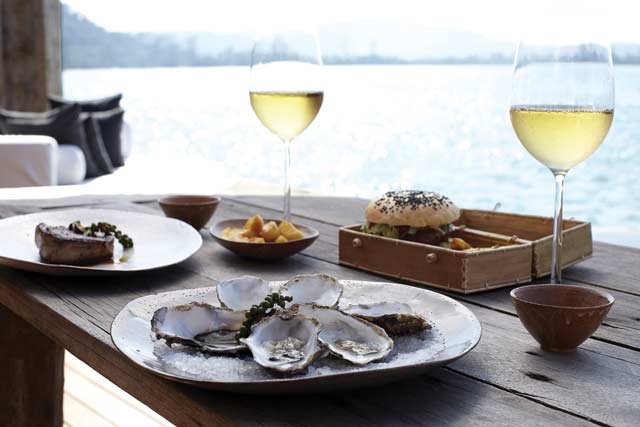
“It is very good for my family to get help with new projects,” says Phea. “We hope to be able to help other families in the same way once our fish project has matured. When we have raised enough, we will give some of them to another family and teach them the skills we have learned.”
Yet it is not just the local people of Prek Svay that are benefiting from Song Saa’s triple bottom line business model. Of the resort’s 200 members of staff, 170 are Cambodian, each with their own story to tell. One of the most remarkable is that of Tim Pheak, a former street kid who was nurtured by Phnom Penh NGO Pour Un Sourir D’Enfant (PSE) and is now the rising star of Song Saa’s kitchen.
Executive chef Neil Wager gurgles superlatives when describing Pheak’s work ethic and natural ability. The young Cambodian will soon spend time in the kitchens of some of the world’s finest restaurants, and top chefs will share their knowledge on Song Saa, in a skills exchange programme that the resort hopes to eventually roll out across most departments. As Rory Hunter says: “Cambodia is winning at both ends, this is about imparting skills and knowledge that people can then use for the rest of their lives.”
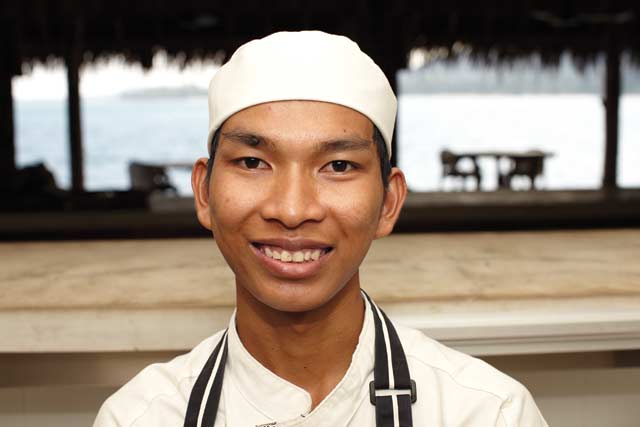
When the Hunters first arrived on the islands six years ago, they promised a job for life to any of the 50 original inhabitants who wanted one. Sin Sarouen decided to stay on and it is immediately apparent that this is one special human being. His vast smile and positive energy are delightfully infectious as he explains his experiences thus far.
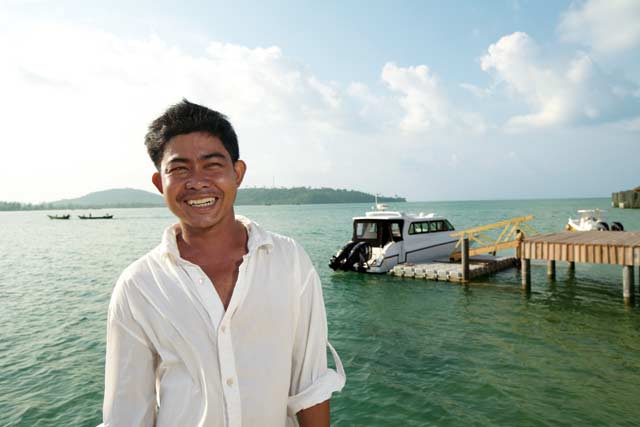
“I have lived here for almost 20 years. I was a fisherman and when Song Saa bought the island I couldn’t speak English but I applied to work with them. I wanted to learn new skills and I wanted to work. Melita and Rory were very kind to me and taught me skills like how to speak English,” says Sarouen.
“At first I was working on a longtail boat as the captain and helping to turn the power generators on and off. They were my first two jobs. Then I joined the conservation team, where I was taught how to dive. Now I have moved up to transport supervisor. I have to organise boats to and from the island, whether it is people or goods, I help oversee the whole operation.”
For all of Song Saa’s personal infinity pools, chenille robes and frightfully well-stocked minibars, for most guests it is people like Sarouen that truly complete their experience. Or people like San Narith, the impeccably courteous, yet inquisitive and laid-back, guest experience supervisor. Or the conservation team’s supremely knowledgeable Nong Channy, who insists on being called ‘Johnny’.
This is a place where people matter. Where the environment matters. A place where, for a while at least, time stands still.
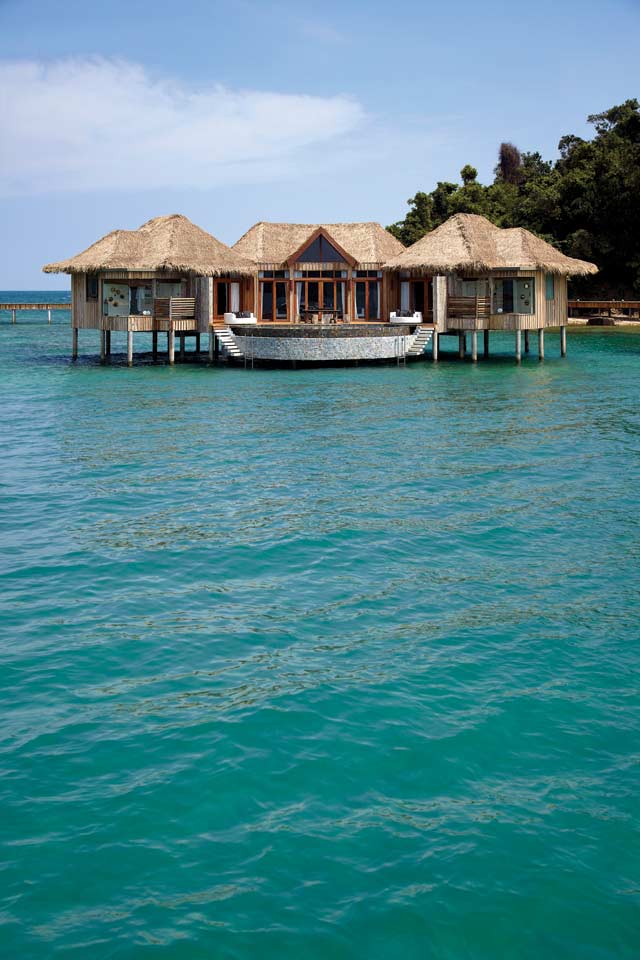
Q & A with executive chef Neil Wager
One of the key features of the Song Saa experience is the degustation dreamland it provides, thanks to English executive chef Neil Wager and his team. The fine-dining Vista restaurant and laid-back Driftwood bar provide vastly different options for breakfast, lunch and dinner, while Wager’s take on Khmer street food is served all afternoon from antique hawker trolleys positioned beside the resort’s main infinity pool.
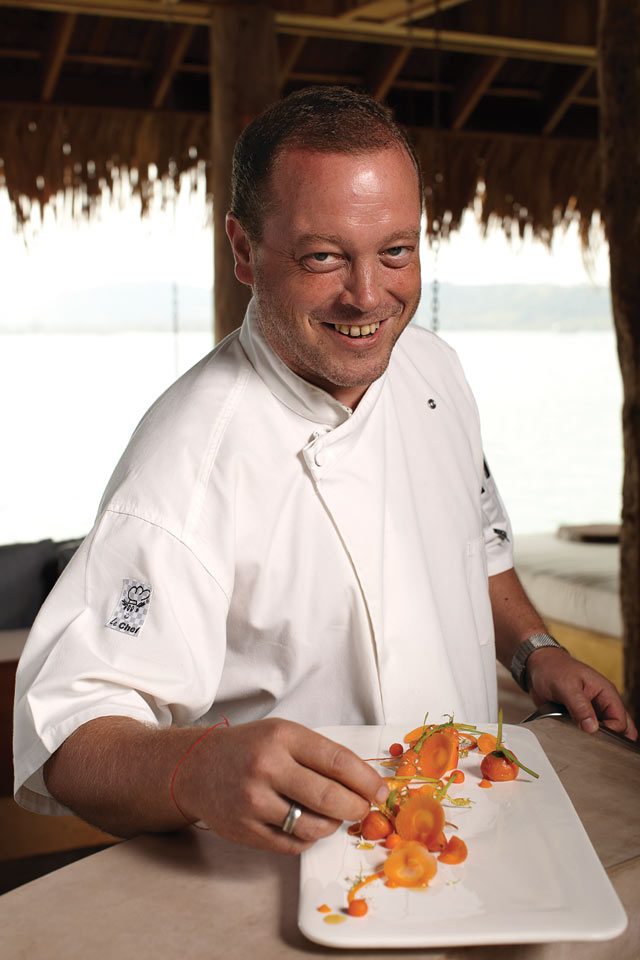
A mixture of homely Western and Khmer cuisine is available in-villa, 24 hours a day. Ever wake at 4am and fancy a Tasmanian ribeye steak with chips, fresh shucked oysters, or tamarind and honey roasted quails? If so, you are well catered for on Song Saa.
‘Destination dining’ options are tailored to the desires of guests and served in style at locations around Song Saa’s two islands. On Koh Ouen, a table can be set on a platform in the pool, with water between the toes. Koh Bong remains largely untouched, connected to its smaller sweetheart by a wooden footbridge, and provides a dinner setting among the emergent rainforest, fireflies twinkling in the perfect darkness.
How did you come to be on Song Saa?
I was working on North Island in the Seychelles but wanted something different. I was sitting by the pool on holiday and did an internet search for ‘new private islands opening in 2012’ and Song Saa was the first one that popped up. I thought, ‘that looks good’, so I sent an email and it went from there.
You’ve had some pretty interesting jobs in the past as well, haven’t you?
I’ve been consultant chef to Sarah Ferguson, the Duchess of York, when she was the face of Weightwatchers in the US. I produced a food line for David Beckham as well, when he did ready meals called ‘Go 3’. I have also worked as a consultant development chef for Jean-Christophe Novelli, John Burton Race and Marco Pierre White. Before that I worked in Formula One for eight years as an executive chef at an event catering company.
What have been the main challenges to starting a kitchen from scratch on Song Saa?
Getting ingredients here is probably the biggest challenge. It’s not that they aren’t available, it is getting them here. Sourcing them is not always easy in Cambodia and neither is getting the kind of equipment I want to use, such as liquid nitrogen.
Is there any piece of equipment you couldn’t do without?
A sous-vide machine, which is a water bath – basically a big square kettle. We’ll marinade meat and then put it in a plastic bag inside the water bath. You cook it for 24 hours at 50 degrees celcius and it will be really tender and soft.
What proportion of your ingredients is sourced locally?
We’ll soon have at least 50% of our ingredients sourced from the islands and Sihanoukville. Then, in terms of Cambodia, it is probably 70% and we’re hoping for that to get higher.
Have you taken the opportunity to get to know local ingredients?
When I first joined the company, I was allowed to tour around Cambodia. I went to Kampot for the pepper and ended up finding salt, which was interesting. We found ibis rice up in Preah Vihear province, which is where the paddy fields are farmed the traditional way with buffaloes instead of metal tractors. By doing that, they’ve seen the ibis population increase. Which, being the national bird, is a very good thing.
What about Cambodian dishes and cooking methods?
I got to learn about the way that local people use ingredients and bring that here. Some of the great chefs in this country, like Luu Meng and Johannes Riviere, are doing lovely traditional recipes in a modern way, so I realised that I should deconstruct those dishes and use the same ingredients in a different way.
What have been the most weird and wonderful recipes you’ve come up with so far?
We made a dessert called Pebble Beach, which contained touches like cocoa butter for the sand, coconut espuma for the sea and coral made from caramel. I guess one that people might consider strange is sea urchin ice cream, or maybe yakitori eel.
What food do you miss from home?
Good back bacon. But we’ve got two pigs coming tomorrow so we are going to start making our own, and English pork sausages too.


